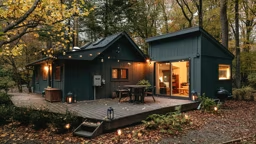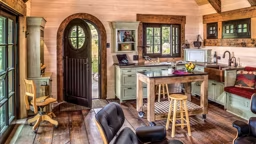Every cabin has a story to tell. And that’s even more true of cabins made of reclaimed timber. Because reclaimed wood provides a tangible link to the past, it beautifully breathes old life into new structures.
Take Dan and Kris Walseth’s recently renovated cabin located near Crosby, Minn. Rather than smelling of fresh paint and new carpet, their place offers a more unusual scent: a hint of salt. The ceiling, made completely of reclaimed Douglas fir, was once part of a railroad trestle bridge that crossed Utah’s Great Salt Lake.
And the wood’s fragrance wasn’t the only thing affected by years of saltwater submersion. Due to the minerals and sulfur that seeped into the lumber, the ceiling sports a lovely greenish hue.
When the Walseths first set out to refurbish their cabin, they were sure of one thing: they wanted their new place to look old – and authentic.
“New wood that is fashioned to look old doesn’t look genuine,” says Dan. “Reclaimed timber is the real deal. It has that rustic, distressed look to it.” Complete with nail holes, bumpy knots, deep cracks and varied textures, reclaimed wood is less uniform than new lumber, providing more variance in the wood’s appearance – giving it character.
“Material costs for ceilings will run from $2.50 per square foot and up, depending on how exotic the wood is,” says Sarah Londerville, owner of Manomin Timbers in Hugo, Minn. Reclaimed timber costs roughly 30 percent more than new wood because the reclaiming process takes significant time and effort. For starters, the mill must ensure that all nails and hardware have been removed before running the boards through milling equipment.
In addition, reclaimed wood is more valuable because it is a finite resource. Once the vintage bridges, buildings and barns are gone, they will yield no more old wood. Additionally, you typically can’t find wide boards in new wood. Only old-growth trees of yesteryear were wide enough to produce wide boards.
“You simply can’t get a 16-inch plank of Douglas fir in new wood,” says Londerville.
Douglas fir, commonly used during the Industrial Revolution (a period from the last half of the 18th to early 20th century), often ended up in factories, bridges and warehouses. And now it has made its way into Dan and Kris’ cabin. It is history the Walseths are eager to share with visitors.
“People are fascinated by the story of reclaimed wood,” says Dan as he gazes up at the ceiling of his dreams.
Let the storytelling begin.
Freelancer Christy Heitger-Casbon’s family recently tore down their 56-year-old cabin to build a new one, but they saved the interior knotty pine boards to use in the new basement.
Take Dan and Kris Walseth’s recently renovated cabin located near Crosby, Minn. Rather than smelling of fresh paint and new carpet, their place offers a more unusual scent: a hint of salt. The ceiling, made completely of reclaimed Douglas fir, was once part of a railroad trestle bridge that crossed Utah’s Great Salt Lake.
And the wood’s fragrance wasn’t the only thing affected by years of saltwater submersion. Due to the minerals and sulfur that seeped into the lumber, the ceiling sports a lovely greenish hue.
When the Walseths first set out to refurbish their cabin, they were sure of one thing: they wanted their new place to look old – and authentic.
“New wood that is fashioned to look old doesn’t look genuine,” says Dan. “Reclaimed timber is the real deal. It has that rustic, distressed look to it.” Complete with nail holes, bumpy knots, deep cracks and varied textures, reclaimed wood is less uniform than new lumber, providing more variance in the wood’s appearance – giving it character.
“Material costs for ceilings will run from $2.50 per square foot and up, depending on how exotic the wood is,” says Sarah Londerville, owner of Manomin Timbers in Hugo, Minn. Reclaimed timber costs roughly 30 percent more than new wood because the reclaiming process takes significant time and effort. For starters, the mill must ensure that all nails and hardware have been removed before running the boards through milling equipment.
In addition, reclaimed wood is more valuable because it is a finite resource. Once the vintage bridges, buildings and barns are gone, they will yield no more old wood. Additionally, you typically can’t find wide boards in new wood. Only old-growth trees of yesteryear were wide enough to produce wide boards.
“You simply can’t get a 16-inch plank of Douglas fir in new wood,” says Londerville.
Douglas fir, commonly used during the Industrial Revolution (a period from the last half of the 18th to early 20th century), often ended up in factories, bridges and warehouses. And now it has made its way into Dan and Kris’ cabin. It is history the Walseths are eager to share with visitors.
“People are fascinated by the story of reclaimed wood,” says Dan as he gazes up at the ceiling of his dreams.
Let the storytelling begin.
Freelancer Christy Heitger-Casbon’s family recently tore down their 56-year-old cabin to build a new one, but they saved the interior knotty pine boards to use in the new basement.
More About This Ceiling
• Previously, the cabin had a low drop ceiling with no insulation. When the Walseths installed the new, high ceiling they added insulation and venting.
• Changes in humidity can cause floors and ceilings to expand and contract (which can cause buckling). To avoid this problem, the Walseths allowed a 1/4-inch gap along all perimeter walls.
• Ceiling material is tongue-and-groove and was blind-nailed on the tongue to the ceiling rafter or 2x4 above.
• Previously, the cabin had a low drop ceiling with no insulation. When the Walseths installed the new, high ceiling they added insulation and venting.
• Changes in humidity can cause floors and ceilings to expand and contract (which can cause buckling). To avoid this problem, the Walseths allowed a 1/4-inch gap along all perimeter walls.
• Ceiling material is tongue-and-groove and was blind-nailed on the tongue to the ceiling rafter or 2x4 above.












